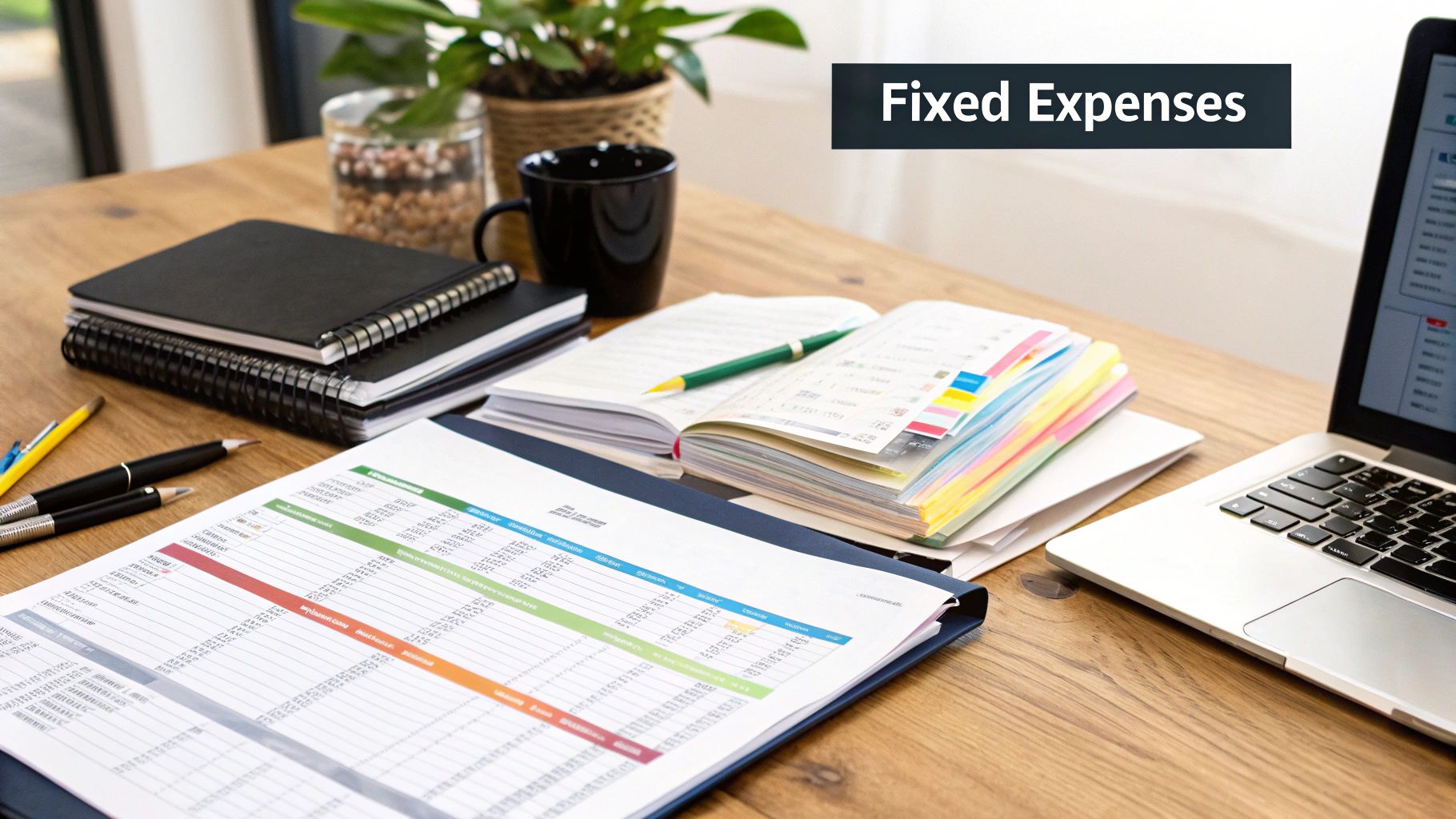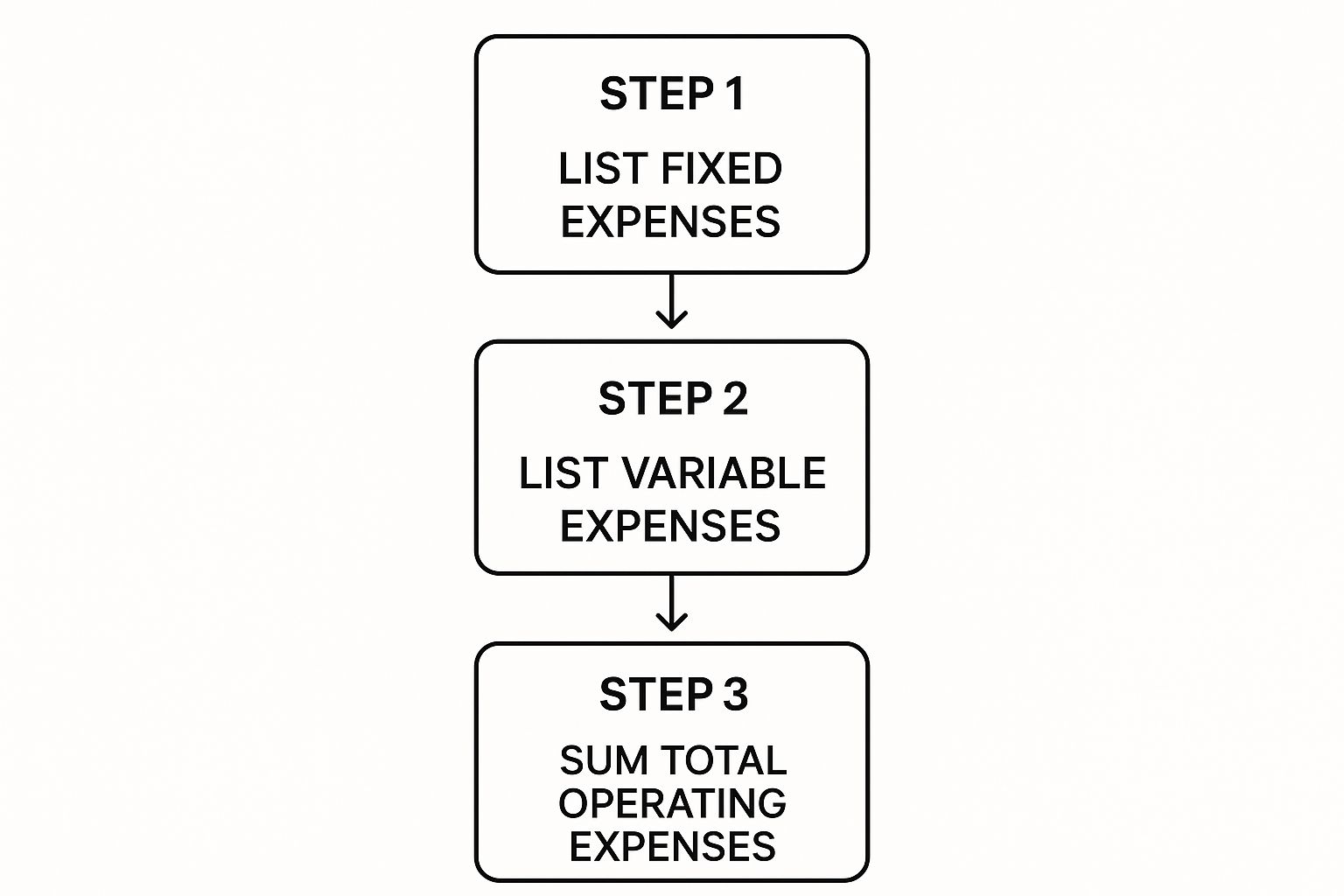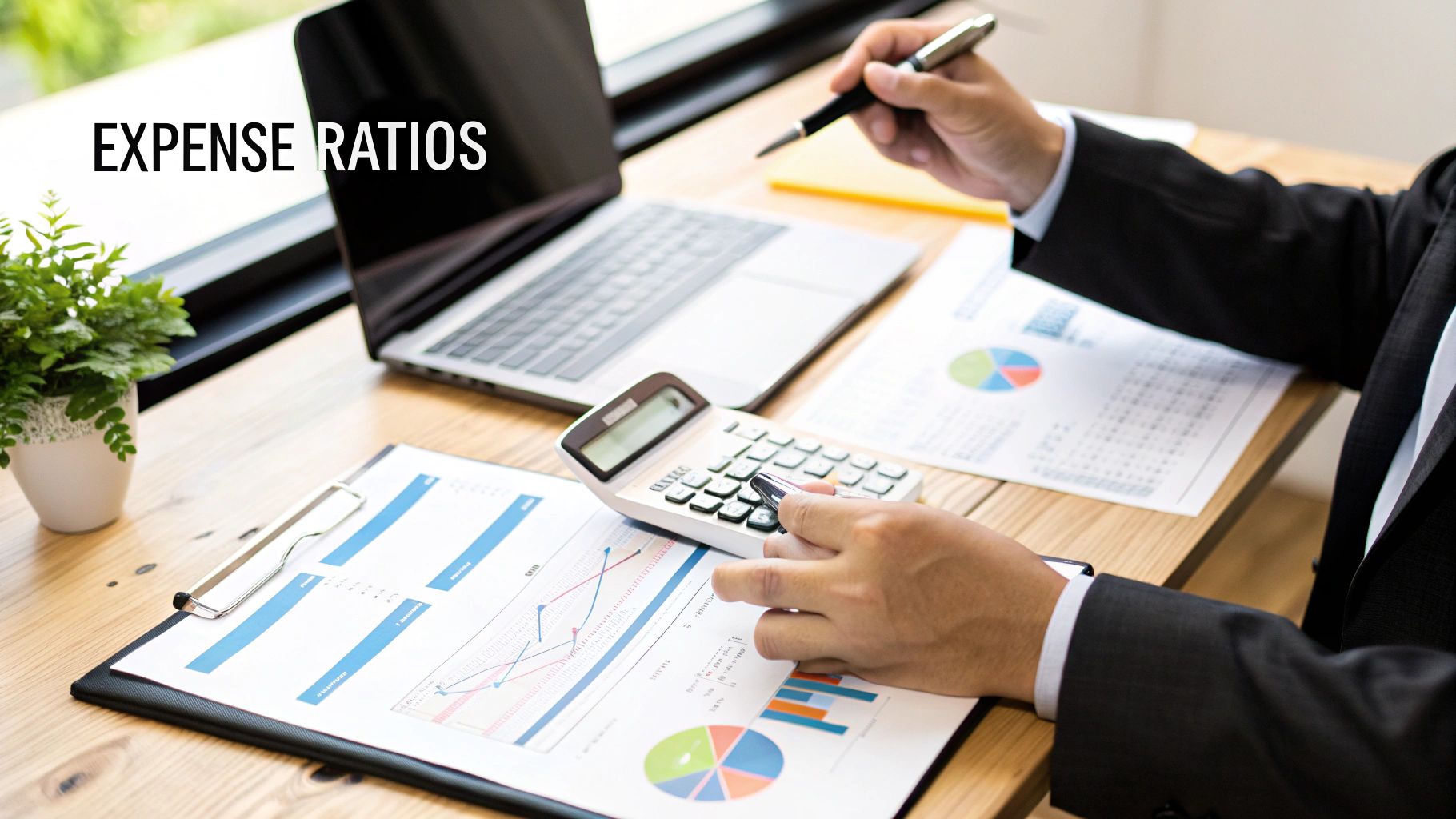How to Calculate Operating Expenses for Your Business
- Sarah Porter

- Oct 5
- 12 min read
To really get a handle on your rental property's finances, you first need to know how to calculate its operating expenses. This isn't just about adding up random costs. It's about totaling all the expenses that keep your property running day-to-day, separate from the cost of acquiring the property itself.
Think of your operating expenses (OPEX) as the sum of all your Selling, General, and Administrative (SG&A) costs. These are the lifeblood expenses of your rental business.
What Exactly Are Operating Expenses?

Before you start plugging numbers into a spreadsheet, you have to be crystal clear on what counts as an operating expense. In the simplest terms, OPEX covers the ongoing costs of keeping your rental property in business and tenant-ready. These are the bills you have to pay whether you have a tenant in place or not.
Getting this distinction right is the bedrock of accurately gauging your property's financial health. Mixing up your expenses will only lead to headaches and bad data down the road.
Key Expense Distinctions
To calculate operating expenses correctly, you have to keep them separate from two other major financial categories you'll encounter as a property owner.
Cost of Goods Sold (COGS): This is less common for simple rental properties but applies if you provide services. Think of it as the direct cost of delivering something to your tenant. For a standard landlord, this is usually zero, but for a short-term rental host, it might include the cost of toiletries or welcome basket items for each new guest.
Capital Expenditures (CapEx): These are the big-ticket items—major purchases or improvements that will provide value for more than a year. Replacing the entire roof, buying a new HVAC system, or repaving the driveway are all classic examples of CapEx, not OPEX.
Understanding the difference here is non-negotiable. If you misclassify a major capital expenditure as a routine operating expense, you'll completely distort your profitability metrics and get a dangerously inaccurate picture of your property's performance.
For example, your monthly property management fee is a classic operating expense. But paying for a full kitchen renovation? That's a capital expenditure.
Operating Expenses vs Other Business Costs
Sorting out your spending can feel tricky at first. This table breaks down the main expense categories to give you a clear reference point.
Expense Type | Definition | Examples |
|---|---|---|
Operating Expenses (OPEX) | Day-to-day costs to keep the business running. | Property taxes, insurance, utilities, property management fees, routine maintenance, advertising for tenants. |
Cost of Goods Sold (COGS) | Direct costs tied to creating products or services. | Welcome basket supplies for an Airbnb, cleaning supplies consumed per turnover. |
Capital Expenditures (CapEx) | Large, long-term investments in assets. | New roof, HVAC system replacement, major renovations, adding a deck. |
Properly tracking these costs is far more than just a bookkeeping chore—it’s a core strategic activity for any serious investor. Operating expenses are the consistent financial drain on your business, and keeping them in check is critical.
Across the broader market, these costs are a massive factor. For U.S. investment-grade companies, operating expenses recently hit $3.052 trillion in a single quarter, one of the highest levels in nearly three years. You can dig into the data yourself in this S&P Global report on corporate expenses. This really drives home just how much of an impact these everyday costs have on the bottom line.
Gathering the Right Financial Information
An accurate operating expense calculation is only as good as the data you put into it. Before you even think about formulas, you need to know exactly where to pull the numbers from.
Think of it like this: you can’t bake a good cake without the right ingredients. Skipping this prep work will leave you with a messy, unreliable result that won't help you make smart decisions.
Start with the Big Picture: Your Income Statement
Your first stop should always be the income statement, which you might also know as a profit and loss (P&L) statement. This document gives you the 30,000-foot view of your rental property's financial health, laying out all the revenue and expenses over a specific time frame.
It’s your financial roadmap for the month, quarter, or year, and it will list most of the key operating costs you’re looking for.
Drill Down into the Details with the General Ledger
While the P&L is great for a summary, the real story is in the details. For that, you need to dig into your general ledger. This is the complete, line-by-line record of every single financial transaction your property has ever been involved in.
The general ledger gives you the granular breakdown that a P&L just summarizes. Don't just settle for a single "maintenance" category on your income statement. Get into the ledger and find the individual invoices that make up that total.
You'll be looking for specific items like:
Property Management Fees: The monthly percentage or flat fee you pay out.
Utility Bills: Water, gas, electricity, and trash services for common areas or vacant units.
Insurance Premiums: Your actual statements for landlord or property insurance.
Marketing Invoices: Costs for listing on Zillow, paying for professional photos, or running ads.
Landscaping and Maintenance Receipts: Every record for lawn care, snow removal, or that leaky faucet repair.
Property Taxes: The official statements from your city or county.
This level of detail is what separates a good analysis from a great one. It shows you exactly where your money is going.
Whatever you do, don't estimate or round your numbers. Your OPEX calculation is a direct reflection of your data quality. Using precise figures from your financial records is the only way to get a true picture of your property's performance.
Put Your Data Collection on Autopilot
Let’s be honest, manually digging through a shoebox of receipts and cross-referencing bank statements is a nightmare. It’s slow, tedious, and a surefire way to make mistakes. This is where good accounting software is worth its weight in gold.
I use QuickBooks for my properties. By linking my business bank accounts and credit cards, the software automatically pulls in and categorizes nearly every transaction.
With a system like this in place, I can run a "Profit and Loss" report that instantly gathers all my operating expenses into one clean, simple view. It ensures nothing gets missed, from a small subscription for lease management software to a major plumbing bill.
Getting your financial house in order is a foundational step. Our guide on [bookkeeping for rental properties made simple](https://www.mypropertymanaged.com/post/bookkeeping-for-rental-properties-made-simple) can walk you through setting up a solid system. Once your data is organized, the actual calculation becomes a piece of cake.
Organizing Your Expenses for Clarity

A shoebox full of receipts or a long, messy spreadsheet is just noise. It tells you money went out the door, but it doesn't offer any real story about where it went or why. To get a true handle on your property's financial health, you have to bring order to that chaos.
The first, non-negotiable step is to group every single cost into logical categories. This isn't just busywork for your accountant; it's how you transform a jumbled list of transactions into a powerful tool for analysis. When you can see precisely where your money is going, you can spot problems, identify savings, and make smarter decisions for your investment.
Creating Your Primary Expense Buckets
For any rental property, you'll find that most of your operating expenses naturally fall into a few key buckets. Setting up this structure is like creating a dashboard for your property's finances, making your income statement instantly understandable.
Here are the essential categories I use for my own properties:
Property Operations & Maintenance: Think of this as the "hands-on" bucket. It's for all the physical costs of keeping the property safe and functional, from fixing a leaky faucet to landscaping, pest control, and cleaning common areas.
Administrative & Professional Services: This is the "business" side of things. It's where you'll track property management fees, legal costs for drafting a lease, your subscription to Stessa or QuickBooks, and even monthly bank fees.
Marketing & Tenant Placement: This covers every dollar you spend to find a great tenant. That means listing fees for your ads, the cost of tenant screening reports, and any commissions you pay to a leasing agent.
Utilities: Even if your lease makes tenants responsible for utilities, you’ll still have costs. This bucket is for the electricity in common hallways, the water bill during a vacancy, or the trash service contract for the building.
Taxes & Insurance: These are the big, predictable costs. Group your annual property taxes and landlord insurance premiums here. If you have an HOA, those fees belong here, too.
By consistently categorizing every single expense, you build a powerful historical record. Over time, you can spot trends, like rising maintenance costs, and make proactive decisions instead of just reacting to problems.
Common Operating Expense Categories and Examples
To make this foolproof, you need a clear system. Having a cheat sheet helps ensure you’re putting every expense in the right place, every time.
Here's a simple table that breaks down the most common operating expense categories with specific examples to guide you.
Category | Description | Specific Examples |
|---|---|---|
Property Operations | Costs related to the physical upkeep of the property. | Plumbing repairs, lawn care, snow removal, HVAC servicing, pest control. |
Administrative | Expenses for the business management of the property. | Property management fees, accounting software, bank service charges, legal fees. |
Marketing & Leasing | All costs associated with finding and securing tenants. | Zillow listing fees, background check services, leasing agent commissions. |
Utilities | Services paid by the owner for the property. | Common area electricity, water/sewer during vacancies, trash removal. |
Taxes & Insurance | Mandatory costs associated with property ownership. | Annual property taxes, landlord insurance premiums, HOA fees. |
Once your expenses are neatly sorted like this, you're no longer staring at a confusing mess of numbers. You have a structured financial overview, which is the perfect foundation for calculating your OpEx accurately.
Getting Real: Calculating OPEX with Practical Examples
You've got your financial data pulled together and organized. Now for the fun part—running the numbers to see the story they tell. The actual calculation for operating expenses is pretty simple, but walking through some real-world examples really makes the concept click.
Let's start with a classic scenario for many investors: a single-family rental property. This example zeroes in on the day-to-day, recurring costs needed to keep the property running—things completely separate from your mortgage.
A Look at a Single-Family Rental
Imagine you own a three-bedroom house that you’re renting out. You're looking back at the last quarter and want to figure out your total operating expenses (OPEX).
Here’s what you spent:
Property Management Fee: $600 (This is 10% of the $2,000 monthly rent, paid over three months).
Landlord Insurance: $300 (Your quarterly premium).
Property Taxes: $1,200 (Paid as one quarterly installment).
Landscaping Service: $240 (A simple $80 a month).
Plumbing Repair: $150 (That one-time fix for a leaky faucet).
HOA Dues: $180 (Comes out to $60 per month).
Adding it all up is straightforward:$600 + $300 + $1,200 + $240 + $150 + $180 = $2,670 in quarterly operating expenses.
This is a great, clear-cut way to see how individual costs contribute to the bigger picture.

As you can see, once you've done the hard work of separating your fixed and variable costs, the final step is just simple addition. If you want to get a more granular estimate for your own properties, our [property management cost calculator for rental owners](https://www.mypropertymanaged.com/post/property-management-cost-calculator-for-rental-owners) can be a huge help.
Shifting Gears to an E-Commerce Store
Now, let's look at a completely different business to see how OPEX changes based on the model. Think about a small online store that sells handmade crafts. Here, the costs are less about a physical building and more about the technology and marketing needed to make sales.
Here’s a snapshot of a typical month:
E-commerce Platform Fee (Shopify): $100
Payment Processing Fees: $350
Digital Advertising Spend (Google & Facebook): $1,000
Email Marketing Software: $50
Shipping Supplies (Boxes, Tape): $200
Part-Time Administrative Assistant Salary: $800
For this online business, the monthly OPEX totals:$100 + $350 + $1,000 + $50 + $200 + $800 = $2,500 in monthly operating expenses.
These two scenarios drive home a critical point. While the formula for calculating OPEX is the same, what makes up those expenses tells you everything about the business. One is heavy on property-related costs; the other is driven by marketing and tech spending.
This principle holds true no matter the industry, even in fields with incredibly complex cost structures. For example, medical practices have seen their operating expenses jump by an average of 11.1% in the past year, thanks to rising wages, supply costs, and technology investments. You can [discover more insights about these rising costs from MGMA](https://www.mgma.com/mgma-stat/medical-practice-operating-costs-are-still-rising-in-2025-heres-how-to-control-them). Getting a handle on these kinds of industry-specific trends is absolutely essential for solid financial planning.
Using Your OPEX to Improve Profitability

Running the numbers is just the beginning. The real magic in knowing how to calculate operating expenses isn't the final figure itself, but what you do with it. Think of this number as your secret weapon for making smarter, more profitable decisions for your rental property.
Simply knowing your total OPEX for one month is a single snapshot in time. To turn that data into a real strategy, you have to zoom out and see the bigger picture.
Turn Your Data Into Actionable Insights
The most powerful thing you can do is track your operating expenses over the long haul. A month-over-month or quarter-over-quarter comparison will reveal trends you’d otherwise completely miss. Did your maintenance costs suddenly spike? Is your utility spending creeping up during vacancies?
Spotting these patterns early allows you to investigate and solve problems before they snowball into major financial drains. This proactive approach is what separates seasoned investors from those who are always just reacting to the next emergency.
Another crucial metric to get a handle on is your Operating Expense Ratio (OER). This simple formula tells you exactly how much of your rental income is being eaten up by the costs of running the place.
Operating Expense Ratio (OER) = Total Operating Expenses / Gross Operating Income
A lower OER is a sign of a healthy, efficient property. It means a smaller slice of your income is needed to keep the lights on, leaving more profit in your pocket. Calculating this ratio lets you benchmark your property's performance against both industry standards and your own historical data.
Analyze and Benchmark Your Performance
Once you have your OER, you can start asking the really important questions. How does your ratio stack up against similar properties in your area? If your OER is 45% but the local average is closer to 35%, that’s a clear signal to start digging into your line items.
This analysis helps you pinpoint specific areas that need attention.
High Maintenance Costs: Are you leaning on a reliable but expensive contractor out of habit? It might be time to get fresh quotes from other qualified pros.
Rising Utility Bills: Could you install energy-efficient appliances or a smart thermostat between tenants? These small upgrades can seriously lower costs, especially during vacancies.
Expensive Insurance Premiums: When was the last time you actually shopped your policy around? Bundling policies or tweaking your deductible could lead to some significant savings.
This isn't about slashing costs blindly. It’s about making strategic adjustments that don’t compromise the quality or safety of your property. By turning a simple accounting task into a continuous improvement cycle, you transform your OPEX figure from a static number into a dynamic tool for boosting your bottom line.
An accurate OPEX calculation is essential because it directly impacts your Gross Operating Profit (GOP). In sectors like hospitality, for example, profit margins have tightened simply because operating expenses grew faster than revenues. You can explore more about managing rising operational costs from CBRE to understand why this kind of precise expense control is so critical in today's market.
Ultimately, careful OPEX management is a cornerstone of understanding your property's overall performance. If you want to see how these expenses fit into the bigger financial picture, check out our guide on how to use a [rental property ROI calculator to maximize your investments](https://www.mypropertymanaged.com/post/rental-property-roi-calculator-maximize-your-investments).
Answering Common Operating Expense Questions
As you dive into calculating operating expenses, you’re bound to run into a few tricky situations. It happens to everyone. Let's walk through some of the most common questions that trip up rental owners so you can get your numbers right from the start.
I often get asked about unexpected, one-time costs. What do you do with that $400 emergency plumbing bill or the sudden need for a pest control visit? Are those really operating expenses if they aren't regular, monthly bills?
Absolutely. An expense doesn’t need to be predictable or recurring to count as an operating cost. If the money you spent was necessary to keep the property running smoothly and safely for your tenant, it belongs in your OPEX calculation. The key difference is that it's not a major improvement or replacement—that’s a capital expenditure (CapEx).
What About Depreciation?
This is another area that causes a lot of confusion. Depreciation is an accounting method for spreading the cost of a large asset (like the building itself, a new roof, or an HVAC system) over its useful life. Even though you don't physically write a check for "depreciation," it's still considered a non-cash operating expense on your financial statements.
So, why bother with it?
It reflects the true cost of use: It’s an honest accounting of your property's assets wearing out over time.
It has major tax benefits: The IRS allows you to deduct depreciation, which can significantly lower your taxable income.
Think of it as the cost of "using up" your property to earn rent.
While depreciation is a crucial operating expense for tax returns and formal accounting, most investors I know exclude it when looking at day-to-day cash flow. For practical budgeting, it’s often better to focus on the actual cash leaving your bank account—the real repair bills, management fees, and property taxes.
Are Loan Payments an Operating Expense?
Getting this one right is critical for accurate bookkeeping. A common mistake is to lump the entire mortgage payment into OPEX. Your mortgage payment is actually two separate things, and you need to treat them differently.
Principal Payment: This is the part of your payment that pays down what you owe on the loan. It is not an operating expense. Paying down debt is a financing activity, not an operational one.
Interest Payment: The interest you pay your lender is an expense, but it's typically classified as a non-operating or financing expense. It’s a cost of having the loan, not a cost of running the property itself.
When you're calculating your property's core operating expenses, you should never include the full mortgage payment. Only the interest portion gets recorded as an expense, and even then, it's smart to keep it separate from your direct OPEX to get a clean look at your property's standalone performance.
At Keshman Property Management, we untangle these financial complexities so you can focus on growing your portfolio. Our team ensures every dollar is tracked and categorized correctly, giving you a perfectly clear picture of your property's financial health. See how our owner-focused services can help you by visiting us at https://mypropertymanaged.com.

Comments